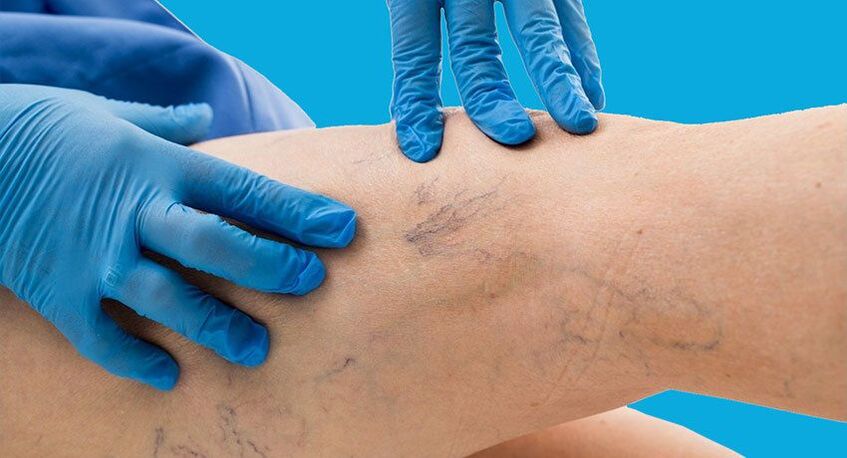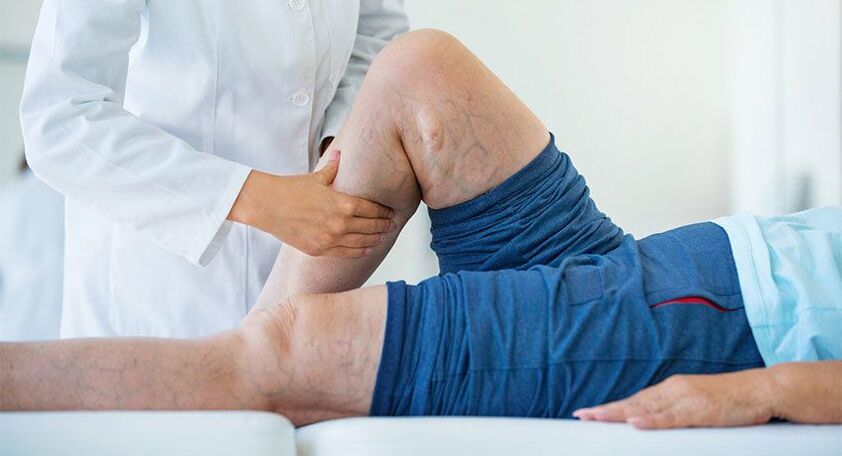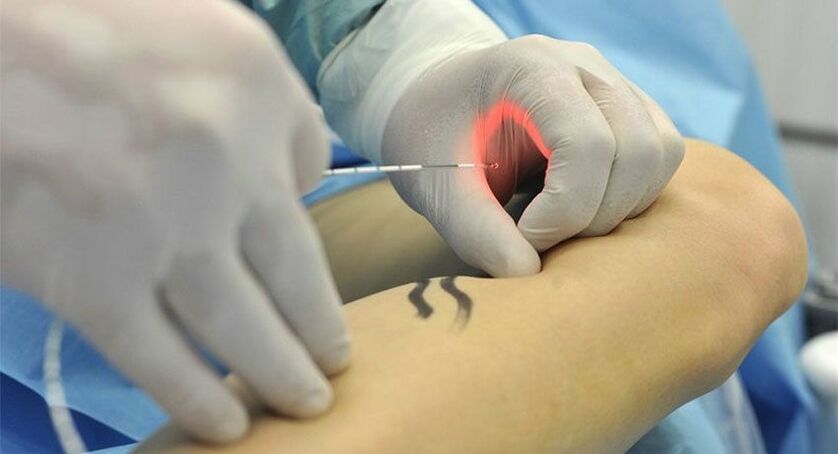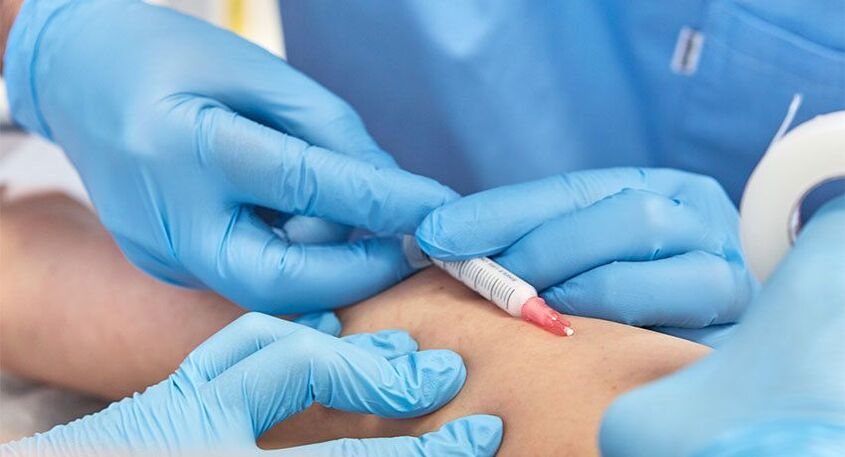Impaired blood flow and stagnation of blood in the venous bed lead to pathological changes in blood vessels - varicose veins. The reasons for the development of this disease can be different, including genetic predisposition (most often), excess weight, hormonal imbalance, pregnancy, arterial hypertension, constipation, lifestyle and professional activity (for example, work that requires a long period of standing on your feet. ).
In all these cases, the progression of the disease follows the same scenario and is associated with two factors: the weakness of the vascular wall and the insufficiency of the venous valve function.
Vascular valves prevent blood from flowing back. If they fail to cope with their task, the blood stagnates and collects (deposits) in the veins. As a result, the vessels not only expand, but also lengthen, become tortuous, and intertwine into varicose veins.
Most often, this disease affects the superficial veins (large and small) on the lower part of the leg. They ensure the outflow of venous blood from the subcutaneous tissue and the skin, which together make up no more than 1/10 of the total circulatory system. The main work is done by the deep veins, connected to the superficial veins through the perforated venous channels.
Treatment of varicose veins always means the removal or absorption of the vein, that is, its exclusion from the general venous circulatory system. But since such ships play a small role in it, their elimination does not have any negative consequences. Their function is easily taken over by the remaining veins.

Symptoms and stages of the disease
Varicose veins are one of the most common vascular diseases. According to statistics, 10-20% of men and 30-40% of women experience it.
The first signs of pathology are the appearance of blue or red vascular patterns on the skin. This may be a network of capillaries or asterisks (telangiectasia). Most often they appear on the legs and thighs, but can also be found on the face, labia (in women), legs, and hands. Spider veins on the face are called rosacea.
Symptoms of varicose veins depend on the stage of the disease. At first it was just heavy, increased leg fatigue, moderate swelling in the evening, which disappeared after rest and sleep. Nocturnal leg cramps are possible.
The characteristic symptom of this disease is pain. Pain in the legs can occur or worsen when walking, standing for a long time, or is persistent, accompanied by a feeling of fullness, burning, and warmth. Enlarged veins become painful when pressed.
In international phlebology, the disease classification is from class 0 to class 6.
At zero level, there are no obvious symptoms; the only complaint might be the heaviness in the legs.
In stage 1, a vascular pattern (telangiectasia) appears and muscle spasms occur at night.
Class 2 disease is manifested by dilated and thickened veins that bulge under the skin.
In stage 3, swelling of the legs (ankles, feet, legs) no longer disappears after a night's sleep, long rest, and becomes persistent.
In stage 4, the skin above the enlarged vein becomes red or blue, hyperpigmentation areas appear, skin itching, dryness, peeling, and inflammation appear.
Further, in stages 5 and 6, the development of pre-ulcers and trophic skin ulcers follow.
Therefore, varicose veins, which start as an aesthetic problem, can lead to serious health problems over time.
Complications
Stagnation of venous blood and its accumulation (deposition) in the vessels of the lower leg causes a drop in blood pressure, hypotension and associated dizziness, fainting, and headache.
The skin over the affected vessels becomes thinner, inflamed, peeling, itching, congestive dermatitis and varicose eczema develop, followed by the formation of trophic ulcers.
Blood clots appear in vessels filled with stagnant venous blood, which can break at any time and, through the general circulatory system, clog important arteries and lead to death.
In the final stages of varicose veins, complications such as phlebitis and thrombophlebitis develop.
The longer the treatment of the disease starts, the higher the risk of complications and more radical methods need to be used to prevent them. Therefore, when symptoms of varicose veins appear, you should not rely on self-medication; it can be good for prevention. But only a doctor can provide real help.

Diagnosis and treatment
As usual, a visit to the doctor begins with a review of complaints, collection of anamnesis and external examination. The main methods for diagnosing varicose veins are Doppler ultrasound, duplex or triplex ultrasound scans of blood vessels.
As a rule, this method provides a comprehensive picture of the disease in order to determine the most appropriate treatment tactics.
If additional data is needed, to clarify the diagnosis, the doctor may prescribe an x-ray with contrast (radiocontrast venography), MRI of blood vessels (magnetic resonance venography), or multi-spiral angiography.
Before performing surgical interventions, both minimally invasive and extensive, a set of standard examinations is prescribed - general urine test, general clinical and biochemical blood test, coagulation test (coagulogram), test for HIV, syphilis, viral hepatitis, fluorography, ECG.
In most cases, the treatment of varicose veins in modern clinics is carried out on an outpatient basis or in a day hospital. It does not require a break from everyday life and after only 1-2 hours you can return to your usual activities. Minimally invasive procedures are performed under local anesthesia or without any anesthesia.
And only radical surgical intervention (phlebectomy) may require short-term hospitalization in the clinic's inpatient unit.
Drug treatment
In the early stages of the development of the disease or for its prevention, the doctor may prescribe drug therapy, including antibiotics and antiseptics (in the presence of inflammation), phleboprotectors, anticoagulants (to prevent thrombosis), phleboprotectors, heparin ointment and other heparins. -contains drugs.
Hirudotherapy can be used as an alternative treatment method.
Conservative therapy includes wearing compression stockings (tights, knee socks) and elastic bandages. It has a limited scope.
Endovascular laser vascular coagulation (EVLC)
This method refers to a minimally invasive method to treat varicose veins. The procedure is performed under local anesthesia on an outpatient basis. Under ultrasound control, a flexible optical fiber light guide connected to a transmitter apparatus is inserted into the vascular bed.
Laser light with a certain wavelength is absorbed by blood cells and vein walls and converted into heat.
As a result, the vessel is sealed and turns into a thin bundle of connective tissue that dissolves on its own.
Laser coagulation is commonly used to treat small and medium-sized varicose veins, especially on the face. But with its help you can also eliminate large varicose veins, including the small and large saphenous veins on the legs.

Radiofrequency ablation
This method, like EVLC, is based on thermal freezing, only radiofrequency radiation, instead of a laser, is used to seal the vessel. Otherwise, the procedure is similar. Under local anesthesia, a radio wave transmitter is inserted into the vein bed, which is absorbed by the blood and vascular walls, converted into heat and provides a coagulation effect. This procedure is performed under ultrasound guidance.
Like laser coagulation, radiofrequency ablation can be used as the main method, alone and sufficient or as part of a complex treatment as an additional method. For example, after surgery remove the main stem to eliminate smaller vascular tributaries.
Sclerotherapy
In this case, the varicose veins are sclerosed-glued together from the inside with the help of a sclerosant. This medicine is given into a vein by injection. It can be liquid or foamy.
This procedure is completely painless; during that time, a slight burning and tingling sensation is possible. To eliminate this sensation, as well as to further compress the vessel, a stream of cold air can be used. This is called cryosclerotherapy.
The use of foam sclerosants has several advantages. They have better contact with the vascular wall, which increases the effectiveness of the procedure. To achieve the result, a much smaller amount of sclerosing agent is needed, because it does not dissolve in the blood.
In addition, it does not spread beyond the procedure area, making the volume easier to control.
Liquid sclerosants are usually used to eliminate small varicose veins, while foam preparations allow sclerosing even large veins.
Sclerosis of small veins and capillaries is usually performed under visual control, and the introduction of foam sclerosant into large vessels is performed under ultrasound control.

Miniphlebectomy
This is a minimally invasive surgical method for varicose vein isolation. It does not require any incisions, anesthesia or epidural.
Treatment for this operation is carried out in a day hospital setting. The doctor performs an ultrasound scan of the vessel and marks it with a marker on the skin. After this, he makes a puncture (an incision of no more than 1-2 mm), where he pulls part of the vein out with a special hook. This area is pinched and cut.
Next, the doctor moves to the next area, makes a puncture, pulls out part of the vein and cuts it. In this way he removed the entire affected vessel.
Skin punctures heal quickly and leave no scars, thus achieving an ideal cosmetic effect. The absence of incisions makes the recovery period minimal. The cut vessel is not sutured, and the puncture does not require stitches - it is only sealed with adhesive plaster.
Phlebectomy
This is a classic surgical operation, which is used less and less recently. It consists of the radical removal of varicose veins along their entire length. To do this, an incision is made in the groin or below the knee, where the probe is inserted into the vessel.
With the help of a probe, the vessel is separated from the surrounding tissue and pulled out. Surgery is performed under general anesthesia or epidural anesthesia.
Restoration
After treatment of varicose veins, wearing compression stockings is necessary. For the first few days it should be worn all the time, in the following weeks only during the day, and can be removed at night. General restrictions for the recovery period include the exclusion of hot baths, steam baths and saunas.
After a minimally invasive operation (laser freezing, radiofrequency ablation, sclerotherapy, miniphlebectomy), it is recommended to get up and walk around. In the future, walking is recommended as a mandatory part of the rehabilitation course (at least 1 hour a day), while all other physical activities should be limited.
The duration of the recovery period depends on the amount of treatment and surgical intervention.

















